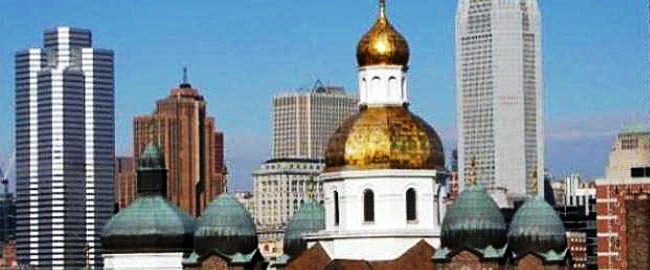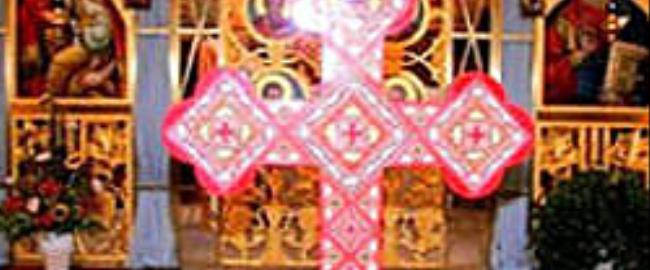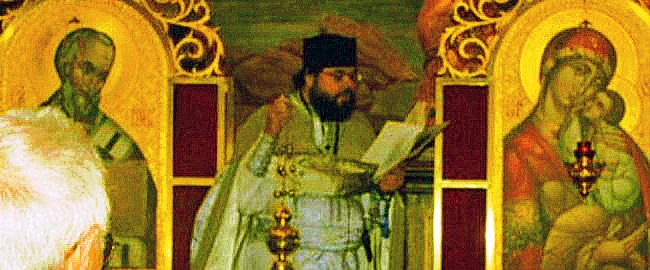What do these terms mean: “Holy Family”,
“James the Less”, “James the Greater”,
“James, the Brother of the Lord”?
The term “Holy Family” means different things to different people.
To avoid confusion, one needs to remember that in the Roman (Latin)
Catholic Church, the term “Holy Family” refers to St. Joseph the
Betrothed, the Most-Holy Theotokos and our Lord, God and Savior, Jesus
Christ.
This is not to be confused with the term “Holy Family” in the way in
which the Byzantine Churches, whether Catholic or Orthodox, use it.
Here it is St. Joachim, St. Anna and the Most-Holy Theotokos, who are
called “the Holy Family”. Why the difference?
The Hebrew tradition did not have separate words for “relative”,
“brother” and “cousin”. Everyone was simply called a “brother” or
“sister”.
According to one tradition, Joseph was previously married and his first wife, by the name of Salome, died before Joseph ever became betrothed to the Theotokos. Thus, by his first wife, Joseph had 4 sons: James (called the Lesser), Joses, Simon, and Jude; and 3 daughters: Esther, Tamara, and Salome, who became the wife of Zebedee. It is explained that when we hear the Gospel say “Mary, the mother of James the Lesser and Joses,” we should be aware that this refers to the Theotokos, for she was considered their step-mother. Thus, St. John the Theologian (and his brother James the Greater) would be the sons of Jesus' step-sister, the nephews of our Lord, and the step-brothers of St. Jude. This is what many of the early Church Fathers believed. It follows from this that St. Joseph would traditionally be portrayed in Christmas icons as an old man with a gray beard (one Ukrainian Christmas carol even refers to “Yosif staren’ky-the old Joseph”), and that Joseph was never ever portrayed in icons together with the Theotokos and Christ, except for the one icon of the Flight into Egypt which shows St. James the Less, as well as the Theotokos and Joseph. Accordingly “Holy Family” would mean St. Joachim, St. Anna, and the Theotokos, as for example in the official icon of the Ukrainian Catholic Church’s “Year of the Family” celebrations which took place in Ukraine in 2003. In explaining why the Holy Apostle John the Theologian would write in his Gospel, "... neither did his brethren believe in Him" (Jn. 7:5), St. Theophylact, Archbishop of Bulgaria, had this to say. He says that at the beginning of the Lord Jesus Christ's earthly ministry, Joseph's sons, Jude among them, did not believe in His divine nature. Tradition says that when St. Joseph returned from Egypt, he began to divide his possessions among his sons. He wanted to allot a share to Christ the Savior, born miraculously and incorruptibly from the All-Pure Virgin Mary. The brothers were opposed to this because Jesus was born of another mother. Only James, later called "The Brother of God in the flesh," offered to share his portion with Jesus. Only much later did Jude come to believe in Christ the Savior as the awaited Christ-Messiah-Anointed, and he followed Him and was chosen as one of the Twelve Apostles. Yet, mindful of his sin, the Apostle Jude considered himself unworthy to be called the Lord's brother, and in his Epistle he calls himself merely the “brother of James”. This tradition is kept in the East.
However, there is another tradition regarding Joseph. Both, St.
John of Damascus (+ circa 780 AD) and St. Jerome (+420 AD), among
others, held firmly that St. Joseph had no children because he had not
been previously married to anyone. Some say that St Jerome
invented, rather than passed on, this tradition because there was an
attack on monastic celibacy in his times and he needed the example of
someone like a celibate Joseph to support his defense of monastic
celibacy. In any case, many in the West chose to follow this
tradition. This is why some people portray St. Joseph as a young
man. This is also why they are not afraid to have Joseph together
with the Theotokos and with Our Lord in one composition, omitting St.
James the Less, and popularly referring to this group as the “Holy
Family.” In this variant tradition, together with St. James the Less,
St. Jude would then be what we today would call “first cousins” of
Jesus. Today, some modern Western icons also follow this second
tradition.
The Byzantine Church’s calendar of saints distinguishes between
the holy Apostle James, the Brother of God in the Flesh (October 23),
and St James, the son of Zebedee (April 30), and St. James, the son of
Alphaeus (October 9). WHY?
OCTOBER 9
Holy Apostle James, the son of Alphaeus, and one of the Twelve Apostles,
was the brother of the holy Evangelist Matthew. He heard the
Lord's words and witnessed His miracles. After the Descent of the
Holy Spirit, the Apostle James Alphaeus and the Apostle Andrew the
First-Called (November 30), made missionary journeys preaching in Judea,
Edessa, Gaza, Eleutheropolis, proclaiming the Gospel, healing all sorts
of sickness and disease, and converting many to the path of salvation.
St James finished his apostolic work in the Egyptian city of Ostrachina,
where he was crucified by the pagans. Originally, there was
confusion because James, son of Alphaeus, was sometimes referred to as
“James the Lesser”, meaning “Lesser” compared to James, the Son of
Zebedee, that is to say the “Lesser of the two James, who are part of
the Twelve”. But there was also an earlier tradition, wherein
James, son of Salome and the Righteous St. Joseph, was sometimes
referred to as “James the Lesser”, meaning “Lesser within the family of
Joseph, in comparison with our Lord, Jesus.” Eventually tradition
attempted to clarify this confusion by renaming James, the son of
Joseph, as James, the “Brother of God in the Flesh-Adelphotheos”.
In this way James, the son of Alphaeus, prevailed as the only one
referred to as “James, the Lesser”.
OCTOBER 23
Holy Apostle James, the “Brother of God in the Flesh-Adelphotheos” was
the son of Salome and the Righteous St. Joseph. After Salome’s
death, Joseph became the Betrothed of the Most Holy Theotokos (December
26). From his early years James was a Nazarene, a man especially
dedicated to God. The Nazarenes vowed to preserve their virginity,
to abstain from wine, to refrain from eating meat, and not to cut their
hair. The vow of the Nazarenes symbolized a life of holiness and
purity, commanded formerly by the Lord for all Israel. When the
Savior began to teach the nation about the Kingdom of God, St James
believed in Christ and became His apostle. He was chosen as the
first Bishop of Jerusalem. Thus in accord with Jewish tradition
Jesus’ earthly ministry passed in to the hands of his closest “next of
kin” that is to say St. James, son of Joseph. This is why he was
initially referred to as “James the Lesser”, meaning “Lesser compared to
our Lord Jesus.” In any case, it was therefore this James who was
the First Bishop of Jerusalem and, as such, it was this James who
presided over the Apostolic Council of Jerusalem and his word was
decisive (Acts 15). In his thirty years as bishop, St James
converted many of the Jews to Christianity. Annoyed by this, the
Pharisees and the Scribes plotted together to kill St James. They
led the saint up on the pinnacle of the Jerusalem Temple and asked what
he thought of Jesus. The holy Apostle began to bear witness that
Jesus is the Christ-Messiah-Anointed, which was not the response the
Pharisees were expecting. Greatly angered, the Jewish teachers
threw him off the roof. The saint did not die immediately, but
gathering his final strength, he prayed to the Lord for his enemies
while they were stoning him. St James' martyrdom occurred about 63
A.D. According to oral tradition, the holy Apostle James composed
a Divine Liturgy, which formed the basis of the Liturgies of Sts Basil
the Great and John Chrysostom. The Church has preserved a
“Universal Letter-Catholic Epistle” of this St James; it is one of the
books of the New Testament.
APRIL 30
The Holy Apostle James, the son of Zebedee, was the brother of St John
the Theologian, and one of the Twelve Apostles. He is sometimes
referred to as “James, the Greater”. He and his brother, St John,
were called to be Apostles by our Lord Jesus Christ, Who called them the
"Sons of Thunder" (Mark 3:17). It was this James, with John and
Peter, who witnessed the Raising of the Daughter of Jairus, the Lord's
Transfiguration on Mount Tabor, and His agony in the Garden of
Gethsemane. St James, after the Descent of the Holy Spirit,
preached in Spain and in other lands, and then he returned to Jerusalem.
He openly and boldly preached Jesus Christ as the Savior of the world,
and he denounced the Pharisees and the Scribes with the words of Holy
Scripture, reproaching them for their malice of heart and unbelief.
The Jews could not prevail against St James, and so they hired the
sorcerer Hermogenes to dispute with the apostle and refute his arguments
that Christ was the promised Messiah Who had come into the world.
The sorcerer sent to the apostle his pupil Philip, who was converted to
belief in Christ. Then Germogenes himself became persuaded of the
power of God, he burned his books of magic, accepted holy Baptism and
became a true follower of Christ. The Jews persuaded Herod Agrippa
(40-44) to arrest the Apostle James and sentence him to death (Acts
12:1-2). Eusebius provides some of the details of the saint's
execution (CHURCH HISTORY II, 9). St James calmly heard the death
sentence and continued to bear witness to Christ. The courage of
St James greatly impressed one of the false witnesses, whose name was
Josiah, so much so that he came to believe in Jesus as the
Christ-Messiah-Anointed. When they led the apostle forth to
execution, Josiah fell at his feet, repenting of his sin and asking
forgiveness. The apostle embraced him, gave him a kiss and said,
"Peace and forgiveness to you." Then Josiah confessed his faith in
Christ before everyone, and he was beheaded with St James in the year 44
at Jerusalem. Whereas St Stephen, one of the seven deacons, was
the first Christian member of the Laity to die as a martyr, it was this
St. James who was the first of the Apostles to die as a martyr.






